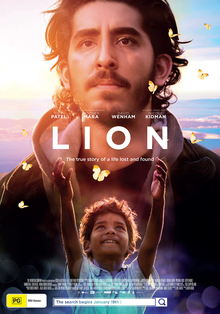
I’m pretty sure I got this pick from The Economist and since I try not to spoil myself, I thought that this was an Indian film. As it turned out, even though about half of it is set in India, it’s really an Australian film, being based on a real-life event that was apparently quite a big deal in the country. I believe it’s the feature film debut of its Australian director Garth Davis.
Five-year-old Saroo is brought up by his single mother together with his elder brother Guddu and two younger siblings. They are so poor that the children need to scrounge for food for themselves. One night Guddu wants to do some night work and Saroo insists on following. They take the train to a nearby stop but Saroo gets tired and goes to sleep. When Guddu fails to return, he wanders around and goes into another train and ends up in Calcutta two days later. As he neither speaks Bengali nor really knows the name of the place where he lives, he ends up being one of innumerable homeless children on the streets. He is nearly victimized a couple of times until someone finally brings him to the attention of the police. They fail to locate his parents and so send him on to an orphanage. While all this goes on, he notices how some of the other children are subjected to horrible abuse. Saroo is one of the lucky ones as he is eventually adopted by a kind Australian couple who brings him up as their son.
The film is made up of two very distinct halves with Patel playing the adult Saroo and child actor playing Sunny Pawar playing his 5-year-old self. The difference in tone between the two halves is stark and there is much more tension in the first half as you fear for the fate of the child. The second half provides a powerful sense of catharsis and relief of course but it can’t compare to the harrowing experiences of Saroo as a child and though the adult Saroo wrestles with guilt and doubt, we already know that an eventual reunion in India is inevitable. The scenes in India are riveting and I suspect one of the best portrayals ever of the lives of homeless Indians. Strangely even as it depicts the abject squalor that the very poorest have to live with, it also captures the country’s beauty and vitality. Saroo’s life in Australia is much more comfortable of course but the scenes there look so plain and bland in comparison, which I think must be part of the director’s design.
I do note that the film appears to have exaggerated the extent of the poverty of Saroo’s family in India for dramatic effect. In real life, his mother was too poor to send them to school but once Saroo and Guddu were gone, she was able to afford to send the two younger siblings to school, suggesting that while poor she isn’t completely bereft of resources. I really liked that just including the character of Mantosh, the other Indian boy the Brierleys adopted shows how lucky Saroo was in having avoided the worst experiences and the trauma leaves a permanent scar. Remaining silent about the exact nature of what happened to him or his subsequent life is tactful I suppose but unsatisfying. This is another reason why the second half of the film feels so weak. It shows Saroo wallowing in his guilt and grief but the various characters don’t really have a frank discussion with him about his experiences. It was good to understand why the Brierleys chose to adopt but it would have been good as well to see the moment when they realized what Saroo had gone through.
Lion is still too sentimental, too much of a crowd pleaser to be a serious art film and it isn’t exactly subtle in its messaging. It is excellent for what it tries to achieve and Saroo’s life story is an inspiring one that is well worth knowing about.